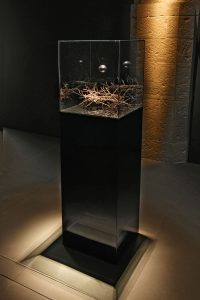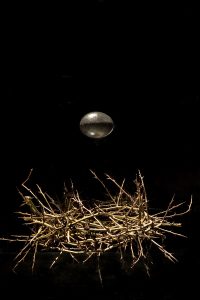The artwork of Paul Fryer focuses heavily on aspects of death, religion and the morbid, all themes that are focused on within the symbolist theory.
Although a lot of Fryer’s work could apply to the symbolist theory, it is ‘Ecce Homo’ (2006). This is a sculptural installation that features a crown of thorns, with a golden egg seemingly floating above it. One of the main points of symbolism, as expressed by the 5 main points of Albert Aurier, is that the artwork must be ideative, meaning that it has to express an idea. In this case, the artwork expresses an idea of the impossible, by heaving the golden egg floating. It all appears to be in the photography making the audience wonder how it is possible. However, in another photograph you can see reflections in the glass, thus shattering the illusion for the audience.
Other theorists believed that artists had the ability to offer salvation through their artwork, particularly a group called the Nabis. By Fryer focusing on creating sculptures that appear to show impossible miracles and religious iconography, Ryder might be leading his audience to salvation.
Theorists seem to mostly agree that symbolism should keep the audience in mystery; by using photography to his advantage, Fryer is able to make it look as though the egg is actually floating, as well as keeping the crown of thorns also looking relatively simple. This stops the shattering of illusion for the audience. However, in some of Fryer’s photographs you are able to see the reflection in the glass of the egg and crown. This could possibly be an indication about how religious acts seem genuine, but when they are closely inspected the illusion disappears.


